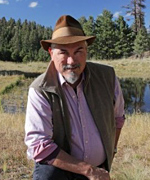 —Alan Dulaney
—Alan Dulaney
Basic facts: Some 36% of Arizona’s total water use stems from the Colorado River. About 40% is groundwater, only 3% is reclaimed water, and the remaining 21% of use comes from in-state streams and rivers. Most of the Colorado River supply is delivered to the three counties of Maricopa, Pinal, and Pima via the Central Arizona Project canal. But the threat of lower flows on the Colorado River has not disappeared, and reconsultation amongst the Basin states for the next interim guidelines on shortage-sharing lies in the immediate future.
One of the most important things about the recent Drought Contingency Plan was what it taught us about achieving a grand bargain amongst all the stakeholders in the state. In June, at the Colorado River law conference at UC Boulder, Tom Buschatzke, Director of ADWR and co-chair of the DCP Steering Committee, discussed some of those lessons. He stated that those lessons will guide the negotiation of the next set of shortage-sharing guidelines (as yet unnamed), which must begin prior to December 31, 2020.
First, the full diversity of stakeholders must be part of the process. This means the participation of tribal entities, such as the Gila River Indian Community, is essential. GRIC holds about half of the total CAP allocation, and the DCP could never have been completed without them. Tribal interests cannot be ignored in any Arizona coalition. Nor can municipal providers, irrigation districts, mines, and yes — even environmental groups — be left out. And no one can expect any mitigation of impacts from lower flows after 2026, as Director Buschatzke made clear.
Second, legislative leaders must be kept up to date in real time. Their support is also essential in coalition building, as changes in statute may be required to make some aspects of the bargain work. The active participation by Representative Rusty Bowers (Speaker of the House) and Senator Karen Fann made sure that the DCP was not derailed by unsatisfied special interests in the Legislature and that the governor was empowered to sign the DCP by the federal deadline.
Third, discussions must be open and transparent, not hidden behind multiple layers of curtains. Everyone must be allowed input, not just the formal members of the coalition seated at the table. Discussion results must be publicly posted. This is totally at odds with how water deals have come about in the past; but times change. No one will trust a secret deal, and trust is essential when every interest will be asked to give up something. In the post-2026 shortage-sharing guidelines, no sacred cows can be allowed — the grand bargain is too important for Arizona.
The current set of interim guidelines was developed in 2007, and runs through 2026. The next set of shortage-sharing guidelines must take into account a future that is warmer and drier, with less water flowing in the Colorado River. But Director Buschatzke was firm in his belief that the lessons learned from DCP will carry Arizona and the other Basin states forward to a new agreement. There may be less water for everyone, but overall the resource will remain sustainable.